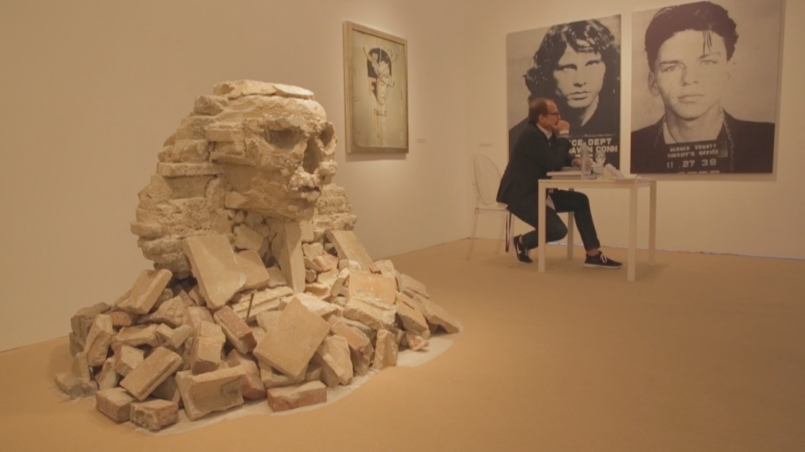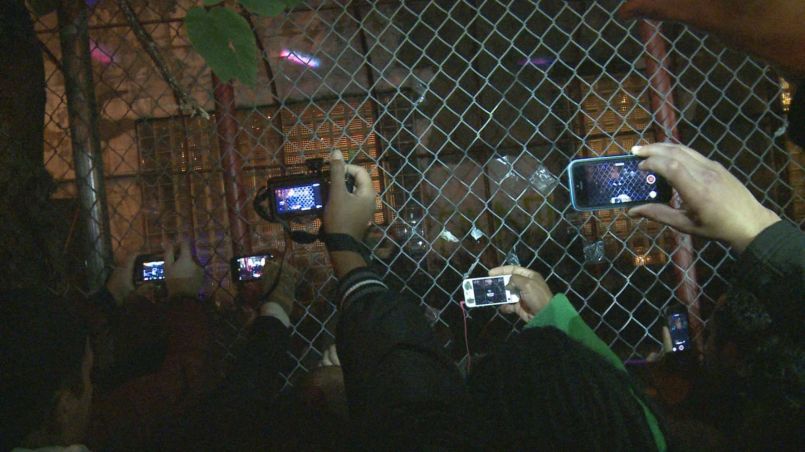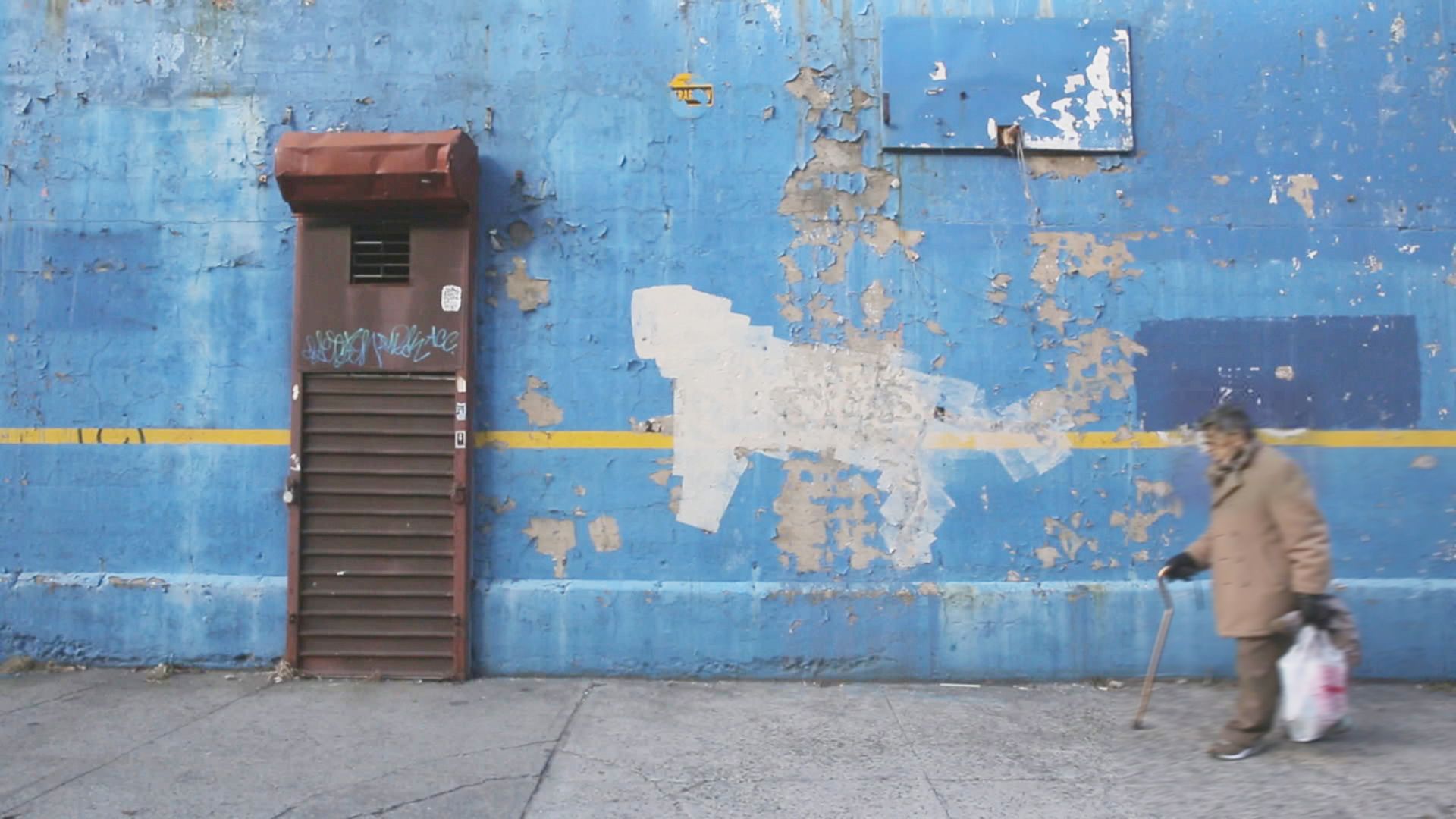When HBO approached director Chris Moukarbel after previously working with him on the unorthodox Me @ the Zoo, he jumped at the chance to chronicle street artist Banksy’s October 2013 New York “residency,” entitled Better Out Than In. His modus operandi? Crowd-sourcing. Moukarbel combed social media and YouTube for hashtags, watching hours upon hours of video filmed by New Yorkers participating in what evolved into an urban scavenger hunt. Eventually Moukarbel stitched select clips together (along with footage of his own) into the cohesive seventy-minute documentary Banksy Does New York, which premiered this week on HBO.
Here are some things you should know about the film, in no particular order and pieced together, Moukarbel-style.
Banksy had nothing to do with the film…at first
But eventually, via Pest Control (the closest thing Banksy has to “people”), Banksy gave Moukarbel notes to clarify direction or accuracy of his pieces. Banksy also requested the title song, Temples’ “Keep It In the Dark.” But, says Mourkarbel, “I can’t say I know anything more about him than I did when I started.”
So stop asking him if he met the guy, okay?
None of Banksy’s street pieces are ever authenticated
Pest Control does not certify Banksy’s street art, claiming that he wants these pieces to exist in their original context. This also makes them hard to sell. Which leads me to…

Banksy’s Sphinx with Stephan Keszler / photo by Mai Iskander
The under-everyone’s-nose theft of Everything But the Kitchen Sphinx in Willets Point, Queens
It was a “baller” move, according to Moukarbel, and one of his favorite clips from the film: while Banksy hunters were admiring the smashed cinderblock sphinx sculpture in the sparse, muddy lot, ooohing and ahhhing and posting on Instagram, some local guys in a moving van pulled up. Out jumped Bernardo “Choco” Veles and a handful of men, who proceed to load the piece into the back of the van, brick by brick, with a typical whadd-ayya-gonna-do-about-it? NYC attitude. “Thieves!” shrieked someone, presumably from Ohio.
“It was like they said, ‘No one can claim this thing. It’s on our property, where we live and work; if we don’t take it, someone else will.’ I think Banksy would have wanted them to have it. He doesn’t put any value judgment on who winds up with his work.”
Here’s the thing, though. “It was like they [Choco and friends] said, ‘No one can claim this thing. It’s on our property, where we live and work [note: Choco owned the neighboring Choco Auto Glass]; if we don’t take it, someone else will,’” says Moukarbel. The film follows Choco for a bit, letting us into his world, and we discover that his business is on the rocks and he’s taking care of his elderly mother. A potential sale of a Banksy piece would turn their lives around. “I think Banksy would have wanted them to have it,” Moukarbel continues. “He doesn’t put any value judgment on who winds up with his work.”
Is that really true for everyone, though?
Let’s talk about Stephan Keszler for a minute
A Banksy hunter-for-profit, he turns up throughout the film. Owner of the Keszler Gallery in Southampton, he’s like the IRL embodiment of gallery manager Serge in Beverly Hills Cop. You know: “Donny, cover this up, iz not sexy.” He’s been “acquiring” Banksy pieces for ages now, yanking them right off the street in New Orleans, Los Angeles, and England; chiseling them off walls in Bethlehem. “I feel like [Banksy] was baiting him,” says Moukarbel. “He knew Keszler would try to take [his work].” Keszler’s the one who winds up offering to take the sphinx from Choco on consignment, potentially benefiting a blue-collar dude just trying to scratch out a living.
I can’t decide how I feel about this. Which brings me to…

Banksy conspiracy theories
They exist. Just like Banksy does, somewhere, some way. The first thing asked of Moukarbel at the HBO screening was, “Is he here? Are you Banksy?” Moukarbel laughed…but then again, there was that one time when he organized a reunion with hardcore Banksy hunters at the site of Inflatable Throw-Up. He noticed a group of hunters off-camera, huddled together, whispering. As Moukarbel approached, they pulled up a pic on a phone of one of the guys who tried to steal Inflatable Throw-Up Keszler-style. They stared at it. They stared at Moukarbel. “This looks exactly like you,” they said, suspicious. Was Moukarbel part of the final piece? Or was this the final piece—this gathering at the site, this mini re-creation?
“The way it was orchestrated seems so cinematic,” Moukarbel says. “It’s like they just put all the pieces in place. And it did look a lot like me.”
Stuff like this can send one into a Rust Cohle–like flat-circle spiral. Because…
Thinking about, or trying to deconstruct, Banksy is an effort in futility
It kind of makes you crazy. Watching Banksy Does New York, I got caught up in flat-circle logic:
Banksy is there on the scene, watching people congregate around his work—no, wait, he’s one of the swagger jackers…and that’s the point of the residence, a sort of social experiment: see what happens and how people react in certain situations. Maybe he’s just teasing us all? Maybe he’s here, right now, at this screening? Small bald man sitting next to me, ARE YOU HE?
I want to believe, you guys! But…are we all Banksy? I mean…

What’s up with locating pieces in far-flung, disparate sections of the city?
As the underlying message of the film posits, it was to bring people together, to force them into areas they’d never normally visit. To force dialogue—even if it was hostile. (“Thieves!”) Banksy Does New York is curated in a similar way to Better Out Than In itself—seemingly random parts that, as a whole, tell a story. “It was about bringing different people together,” Moukarbel confirms. “A real New York story, a portrait of the city.”
It’s a sweet, pure vision. And at the end of the film, as the end credits roll over Frank Sinatra’s “Theme from New York, New York”*, as the message “Save 5Pointz” runs across the screen, I buy into it 1,000 percent. There’s a lifting of the spirit, combined with a sadness, a nostalgia for an NYC that once was and an NYC that still is, connected by creatives, artists, entrepreneurs (dudes in East New York charging $20 to take a photo with the Beaver piece, I’m talking to you), and parasites alike. And that’s what makes the city so great.
Or maybe I’m just overthinking the whole thing. FL
*There’s a story behind that, just as circular as the concept of Banksy himself:
While mining footage for the film, Moukarbel discovered two extremely committed Banksy hunters, vloggers Two Way Traffic, and he followed their daily excursions in real time. On day 31, the final day of the residency, the duo is in their car trying to reach Inflatable Throw-Up—gigantic mylar balloons floating across the side of a building, spelling out B-A-N-K-S-Y-! in old-school graffiti writing. They don’t make it: the balloons are stolen and the cops are called before they’re even close to the site.
But at least they’re following the chaos at the scene via Instagram and Banksy’s official site, which is also home to the audio tour. As Sinatra’s “Theme from New York, New York” closes out the tour, Kurt says, “What a fitting end to the movie, as the credits roll…this was the song he had on his audio tour. That’s the song he wanted for the end of the movie.” He turns to face the camera. “Hey, man, if anyone wants to collaborate on the film version of the Better Out residency, I’m up for it.”
According to Moukarbel, they already were—Two Way Traffic just didn’t know it yet. Banksy Does New York’s closing credits track was confirmed.







